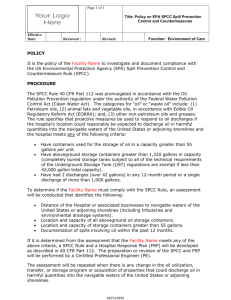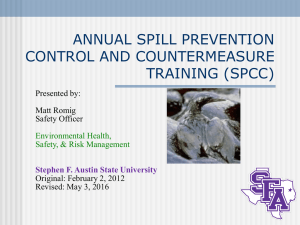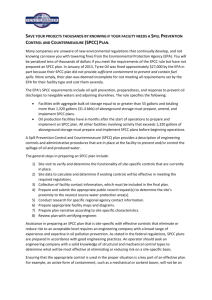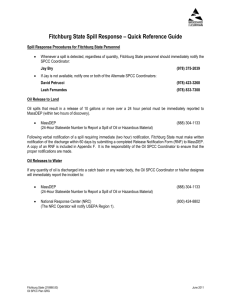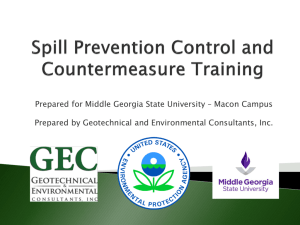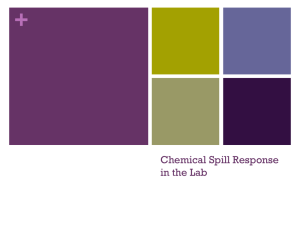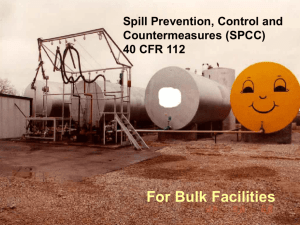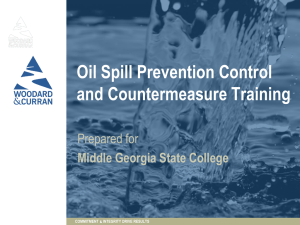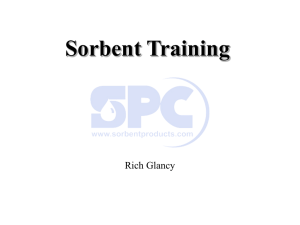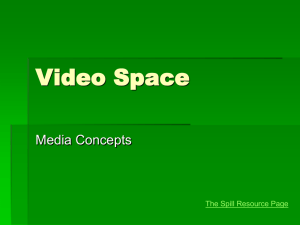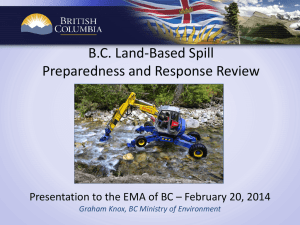SPCC Training - Marquette University
advertisement
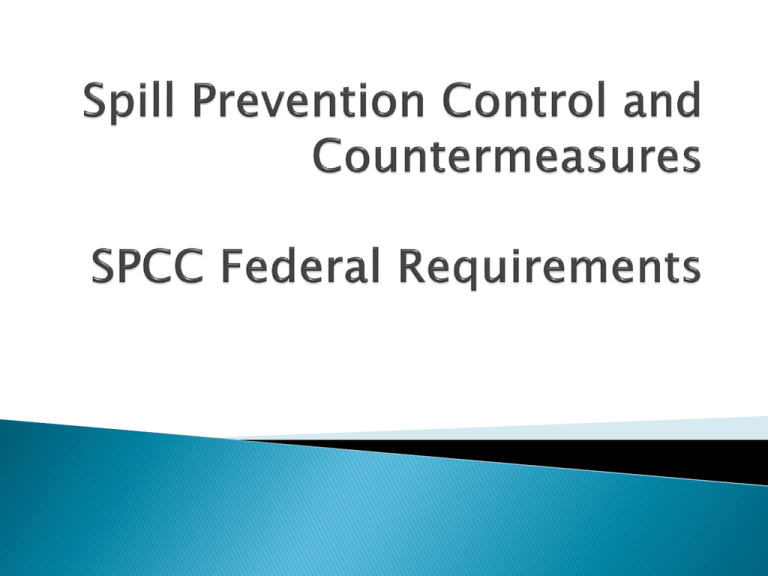
The Federal Clean Water Act specifies the requirements for SPCC Plans The Code of Federal Regulations 40 CFR 112 details requirements of the SPCC Plan The SPCC regulations establish procedures, methods, and equipment needed to prevent oil discharges into waters of the United States • A facility is required to have a SPCC Plan if it has: – Total above ground oil storage of more than 1,320 gallons; OR – Total below ground oil storage of more than 42,000 gallons; AND – There is the potential for oil to reach streams or other water bodies • Marquette University meets these requirements and therefore is required to have a SPCC Plan The Marquette University SPCC Plan is kept on file at the Environmental Health & Safety Office located in Zilber Hall, Suite 212 ◦ The document was prepared and certified by a Registered Professional Engineer and is approved by upper management of Marquette University The Marquette University SPCC Plan includes: ◦ Description of oil storage locations ◦ Description of secondary containment for oil storage ◦ Locations of spill clean-up and containment materials ◦ Maps or other information to indicate where a release will migrate ◦ Spill history, potential spill sources, and spill prevention techniques ◦ Spill contingency plan ◦ Other applicable guidelines Marquette University To familiarize employees with the written SPCC Plan To help employees identify oil storage locations and loading procedures To assist in identifying spill pathways To provide a discussion of spill prevention procedures To familiarize the employee with appropriate spill response procedures and use of spill response equipment. All petroleum based oils. ◦ Fuel Oil, Gasoline, Hydraulic Fluid, Motor Oil, etc. Animal fats and oils. Fish and marine mammal oils Vegetable oils All the above oils mixed with wastes Never mix used oil with other wastes Oil Storage at Marquette University includes; ◦ ◦ ◦ ◦ ◦ Aboveground Storage Tanks (ATS) Hydraulic Elevator Systems and Reservoirs Waste Oil Collection Stations Waste Cooking Oil 55 Gallon Drums in various locations What Oil is Regulated at Marquette? Gasoline and Diesel Fuel for Vehicles What Oil is Regulated at Marquette? Larger Oil-filled Elevator Reservoirs What Oil is Regulated at Marquette? Other oil Stored in Containers 55-Gallons or Larger What Oil is Regulated at Marquette? Cooking Oil/ Grease What Oil is Regulated at Marquette? Cooking Oil/ Grease Operating Procedures implemented to prevent oil spills. ◦ Examples: Regular inspections, SPCC On-Site Coordinator observing tank filling procedures. Control Measures installed to prevent oil from reaching navigable waters. ◦ Example: Secondary containment. Countermeasures to contain, cleanup, and mitigate the effects of an oil spill. ◦ Examples: Cleanup and spill equipment availability on site, available list of contacts and phone numbers for employee use during spills. Spill Prevention ◦ Installation of proper equipment, repair of malfunctioning systems, inspections, and good fueling and handling practices Spill Control ◦ Monitoring of leak detection, proper reporting, inspection of containment and piping systems. Spill Countermeasures ◦ Quick, proper, and safe response to spills. In some areas, oil can enter the “Navigable Waters or adjoining shorelines” by: ◦ Direct spillage into a storm drain. Never allow oil to drain into an open drain or into a ditch or waterway. Oil containing equipment (i.e. a vehicle) is never to be rinsed or washed near a storm drain or waterway. Damage to or accidental release from oil delivery equipment during loading or unloading of oil at fill ports of storage tanks. Catastrophic Tank Failure Fuel tanker failure during delivery Motor vehicle accident involving oil delivery equipment. Small overfill at fill port of fuel tanks. Spillage of oil during transfer to or from drums and tanks. Leaking and or failure of pipes and pumps. Leaking and or failure of drums. Routine Inspections ◦ Our site specific SPCC plan includes the frequency schedule and checklist necessary for proper inspection. ◦ Ensure that necessary maintenance and repairs are completed as scheduled and recorded. ◦ SPCC specific inspections are conducted on a Weekly, Monthly, Quarterly, and Annually basis as outlined in the Periodic Inspection Checklist. ◦ Inspection records must be kept for a minimum of three years Definition of proper containment ◦ All bulk storage containers of oil must be located in containment sufficient for the entire capacity of the largest container and sufficient have sufficient freeboard to contain an additional 10% volume. ◦ Secondary containment must be impervious material ◦ Secondary containment is NOT required for Qualified Oil-Filled Operational Equipment such as transformers or electrical switches currently in use. Routine Inspection ◦ Can be performed by any SPCC On-site Coordinator. ◦ Check for indication of oil leaks on floors, pallets, dikes, retaining walls, and berms. ◦ Water must be able to drain out ONLY if there is no noticeable sheen. ◦ Refer to your site specific SPCC plan for specific details regarding your site’s secondary containment inspection. Discovery of Release ◦ Extinguish or remove any source of ignition. ◦ Identify the material and its point of release. ◦ Attempt to stop the release at its source if it is safe to do so. ◦ Contain material to prevent release into the environment ◦ Initiate the spill reporting procedure as specified in your site specific SPCC plan ◦ Recover or clean up spilled material ◦ Decontaminate tools and equipment ◦ Arrange for disposal of waste materials through EH&S ◦ EH&S is responsible for reporting to outside agencies. For “large spills” that can’t be controlled by in-house personnel and materials contact: Veolia Environmental Services EMERGENCY RESPONSE 1-800-688-4005 Documentation Public Safety 8-1911 should be notified of all spills. Public Safety will be responsible writing spill reports based on information provided by the SPCC On-Site Coordinator detailing the following information: ◦ ◦ ◦ ◦ ◦ ◦ Date, time, and duration of release Type of incident Material involved Volume of material involved SPCC Plan Discrepancies Actions taken to avoid future incidents All spill reports must be sent to EH&S A Spill Report will be completed by Public Safety, reviewed with affected parties, and filed with EH&S. Be sure to include information on: ◦ How to prevent another occurrence ◦ Effectiveness of the response Remember to restock your spill kit with any used items and/or add items that may be useful in the future if warranted. Floor (Oil) Dry Shovels, brooms, and dust pans Spill Kit: ◦ ◦ ◦ ◦ ◦ Absorbent booms, pads, and socks Protective gloves and safety goggles Caution tape Collection bags Labels Wehr Life Sciences, room # 018 Service Garage Straz Tower, room #005 McCormick Hall, room #200CA TW Chemistry, room #109B EPA SPCC Management Guidelines http://www.epa.gov/emergencies/content/spcc/index.htm Marquette University Department of Environmental, Health & Safety Please contact us at 288-8411 with any questions or concerns that you may have.
